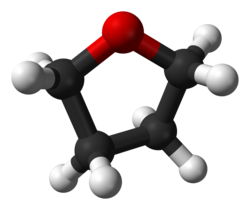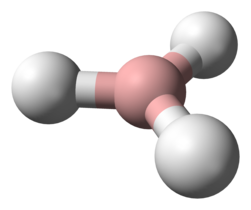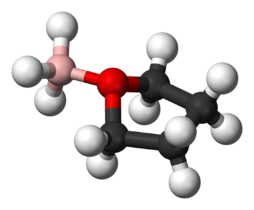219:
186:
201:
281:
of the copper atoms within the structure. This reaction can also be considered a reaction between a base and a Lewis acid with the copper atom in the electron-receiving role and the
468:
334:
297:
is formed from a precursor ion and contains all of the constituent atoms of that ion as well as additional atoms or molecules. Adduct ions are often formed in a
81:. It can be considered as a single product resulting from the direct combination of different molecules which comprises all atoms of the reactant molecules.
434:
377:
218:
138:. Many Lewis acids and Lewis bases reacting in the gas phase or in non-aqueous solvents to form adducts have been examined in the
509:
277:. Upon formation of the adduct, a new extended phase is formed in which the gas molecules are incorporated (inserted) as
162:
on the tin and the ethyl groups on oxygen. But when the Lewis base is tetrahydrofuran, steric repulsion is reduced. The
504:
514:
185:
158:. For example: trimethyltin chloride, when reacting with diethyl ether, exhibits steric repulsion between the
151:
255:
248:
147:
402:
200:
364:
Housecroft, Catherine E.; Sharpe, Alan G. (2008). "Acids, bases and ions in aqueous solution".
451:
373:
369:
298:
274:
54:
432:(M = Al and Ga) upon Small-Molecule Binding and the Competitive Binding of CO and Ethylene".
482:
443:
410:
348:
244:
70:
66:
62:
53: 'drawn toward'; alternatively, a contraction of "addition product") is a product of a
428:
Capracotta, M. D.; Sullivan, R. M.; Martin, J. D. (2006). "Sorptive
Reconstruction of CuMCl
263:
232:
191:
143:
97:
406:
155:
46:
498:
116:
478:
344:
159:
473:
339:
310:
282:
30:
This article is about the chemical term. For the anatomical term of motion, see
65:
containing all atoms of all components. The resultant is considered a distinct
315:
89:
85:
477:, 2nd ed. (the "Gold Book") (1997). Online corrected version: (2006–) "
343:, 2nd ed. (the "Gold Book") (1997). Online corrected version: (2006–) "
486:
352:
163:
139:
78:
38:
31:
455:
259:
74:
58:
17:
447:
414:
278:
254:
Adducts are not necessarily molecular in nature. A good example from
225:
206:
93:
92:. A good example is the formation of adducts between the Lewis acid
294:
243:
Compounds or mixtures that cannot form an adduct because of
154:
are examples of Lewis acids that form adducts which exhibit
27:
Product of direct addition of two or more distinct molecules
171:
Ball and stick diagram of the Lewis adduct between BH
393:Vogel G. C.; Drago, R. S. (1996). "The ECW Model".
285:of the gas molecule in the electron-donating role.
166:can provide a measure of these steric effects.
8:
168:
273:. The latter is a solid with an extended
435:Journal of the American Chemical Society
269:
152:bis(hexafluoroacetylacetonato)copper(II)
134:
130:
126:
122:
111:
107:
103:
96:and the oxygen atom in the Lewis bases,
327:
181:
7:
69:. Examples include the addition of
474:Compendium of Chemical Terminology
340:Compendium of Chemical Terminology
25:
479:adduct ion (in mass spectrometry)
217:
199:
184:
368:(3rd ed.). Harlow, Essex:
1:
395:Journal of Chemical Education
84:Adducts often form between
531:
29:
61:, resulting in a single
57:of two or more distinct
487:10.1351/goldbook.A00139
353:10.1351/goldbook.A00138
249:frustrated Lewis pairs
510:Solid-state chemistry
256:solid-state chemistry
224:Lewis adduct between
148:trimethyltin chloride
442:(41): 13463–13473.
407:1996JChEd..73..701V
366:Inorganic Chemistry
177:
505:Chemical reactions
258:is the adducts of
169:
515:General chemistry
448:10.1021/ja063172q
415:10.1021/ed073p701
379:978-0-13-175553-6
370:Pearson Education
299:mass spectrometer
275:lattice structure
241:
240:
67:molecular species
16:(Redirected from
522:
489:
466:
460:
459:
425:
419:
418:
390:
384:
383:
361:
355:
332:
272:
245:steric hindrance
221:
203:
188:
178:
137:
114:
71:sodium bisulfite
63:reaction product
21:
530:
529:
525:
524:
523:
521:
520:
519:
495:
494:
493:
492:
467:
463:
431:
427:
426:
422:
392:
391:
387:
380:
372:. p. 199.
363:
362:
358:
333:
329:
324:
307:
291:
271:
267:
264:carbon monoxide
235:
229:
222:
213:
210:
204:
195:
189:
174:
144:Trimethylborane
136:
132:
128:
124:
120:
113:
109:
105:
101:
98:tetrahydrofuran
55:direct addition
35:
28:
23:
22:
15:
12:
11:
5:
528:
526:
518:
517:
512:
507:
497:
496:
491:
490:
461:
429:
420:
401:(8): 701–707.
385:
378:
356:
326:
325:
323:
320:
319:
318:
313:
306:
303:
290:
287:
239:
238:
237:
236:
227:
223:
216:
214:
208:
205:
198:
196:
190:
183:
172:
156:steric effects
26:
24:
14:
13:
10:
9:
6:
4:
3:
2:
527:
516:
513:
511:
508:
506:
503:
502:
500:
488:
484:
480:
476:
475:
470:
465:
462:
457:
453:
449:
445:
441:
437:
436:
424:
421:
416:
412:
408:
404:
400:
396:
389:
386:
381:
375:
371:
367:
360:
357:
354:
350:
346:
342:
341:
336:
331:
328:
321:
317:
314:
312:
309:
308:
304:
302:
300:
296:
288:
286:
284:
280:
276:
265:
261:
257:
252:
250:
246:
234:
230:
220:
215:
211:
202:
197:
193:
187:
182:
180:
179:
176:
167:
165:
161:
160:methyl groups
157:
153:
149:
145:
141:
118:
117:diethyl ether
99:
95:
91:
87:
82:
80:
76:
72:
68:
64:
60:
56:
52:
48:
44:
40:
33:
19:
472:
464:
439:
433:
423:
398:
394:
388:
365:
359:
338:
330:
301:ion source.
292:
283:pi electrons
253:
242:
170:
83:
50:
42:
36:
311:Adductomics
289:Adduct ions
247:are called
90:Lewis bases
86:Lewis acids
499:Categories
322:References
316:DNA adduct
293:An adduct
125:·O(CH
106:·O(CH
77:to give a
45:(from
164:ECW model
140:ECW model
79:sulfonate
59:molecules
39:chemistry
32:adduction
456:17031959
305:See also
260:ethylene
212:molecule
194:molecule
75:aldehyde
51:adductus
403:Bibcode
279:ligands
175:and THF
100:(THF):
18:Adducts
454:
376:
345:adduct
268:CuAlCl
94:borane
73:to an
43:adduct
469:IUPAC
335:IUPAC
49:
47:Latin
41:, an
452:PMID
374:ISBN
231:and
150:and
88:and
483:doi
481:".
444:doi
440:128
411:doi
349:doi
347:".
295:ion
266:of
262:or
233:THF
192:THF
115:or
37:In
501::
471:,
450:.
438:.
409:.
399:73
397:.
337:,
251:.
226:BH
207:BH
146:,
142:.
129:CH
121:BH
119::
102:BH
485::
458:.
446::
430:4
417:.
413::
405::
382:.
351::
270:4
228:3
209:3
173:3
135:2
133:)
131:2
127:3
123:3
112:4
110:)
108:2
104:3
34:.
20:)
Text is available under the Creative Commons Attribution-ShareAlike License. Additional terms may apply.


